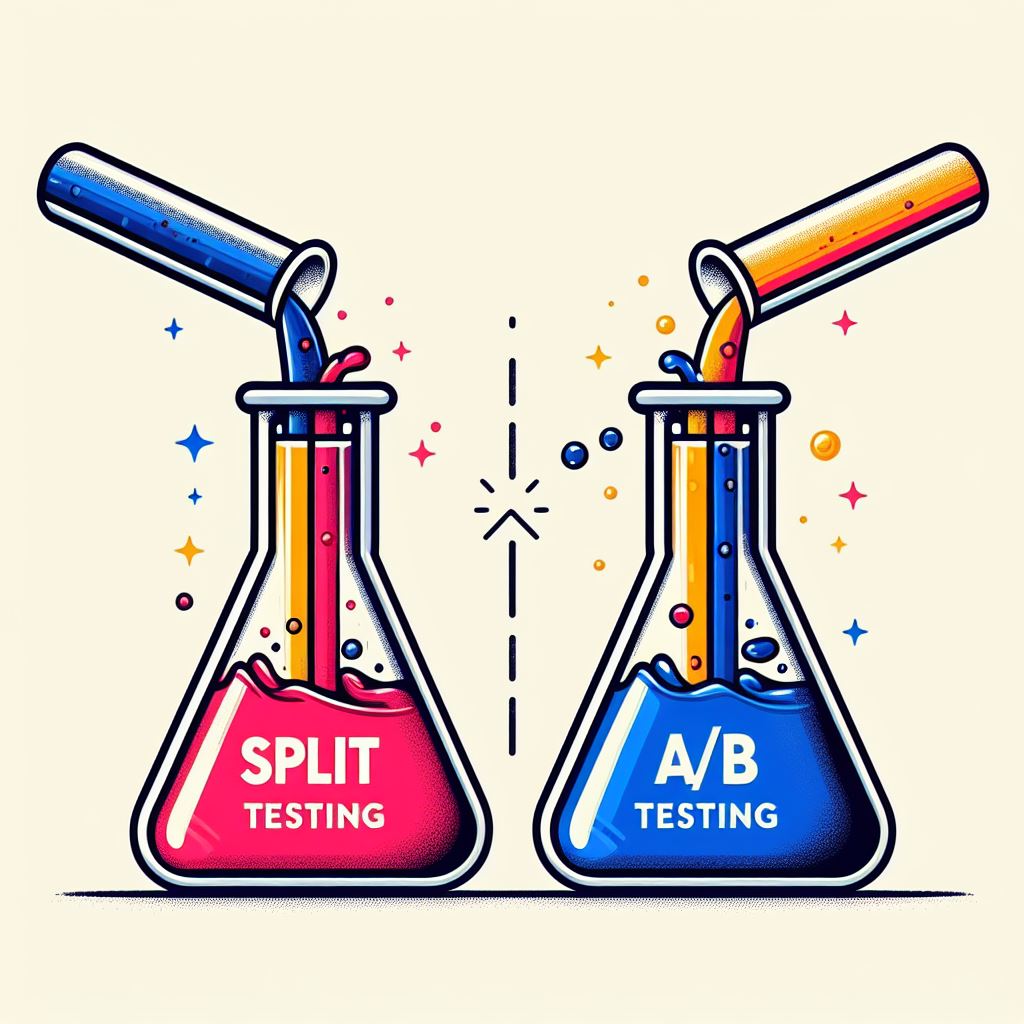Imagine you’re a digital marketer looking to optimize your website. You decide to run a split test on two different versions of your landing page, changing only the color of the call-to-action button. Surprisingly, one version significantly outperforms the other, leading to increased conversions.
But, does split testing truly work as effectively as this example suggests? The answer may not be as straightforward as you think. Let’s explore the nuances and effectiveness of split testing in the world of marketing.
Key Takeaways
- Split testing is an effective method for comparing versions and making data-driven decisions.
- It provides insights into consumer behavior, helping tailor marketing campaigns for better effectiveness.
- Implementing split testing in email marketing can enhance personalization and improve engagement metrics.
- Testing different elements like content formats in emails can lead to higher open rates and better conversion rates.
Split Testing Definition
When conducting split testing, also known as A/B testing, marketers compare versions of a web-page or campaign element, thereby helping to verify the one with more conversion potential. Split testing is a crucial tool in marketing that allows you to make data-driven decisions by analyzing the conversion performance. By testing two versions simultaneously, you can identify which elements resonate best with your audience and lead to higher conversion rates. This method provides concrete evidence on what works and what doesn’t, enabling you to optimize your campaigns for maximum effectiveness.
Split testing helps you understand consumer behavior and preferences by measuring their responses to different variations. It eliminates guesswork and allows you to tailor your marketing strategies based on real-time data. By continuously testing and refining your content, you can improve engagement, click-through rates, and ultimately, your return on investment. Embracing split testing empowers you to make informed decisions backed by solid evidence, ensuring that your marketing efforts are optimized for success.
What Is Split Testing In Marketing?
To understand the impact of split testing in marketing, you must grasp its significance in refining your strategies through empirical analysis of audience responses to different variations.
Split testing, also known as A/B testing, is a method used by marketers to compare two versions of a webpage, email, ad, or other marketing assets to determine which one has superious performance metrics. By randomly showing these variations to different segments of your audience, you can measure and analyze their responses, allowing you to make data-driven decisions to optimize your marketing efforts.
This process enables you to identify which elements resonate best with your target audience, such as headlines, images, call-to-action buttons, or layout designs. Split testing provides valuable insights into consumer behaviour, preferences, and trends, helping you tailor your marketing campaigns for maximum effectiveness.
How To Do A/B Testing
For effective A/B testing, meticulously plan your experimental variations to ensure meaningful and actionable results. A well-executed A/B test can provide valuable insights into consumer behaviour and preferences. Here are some key steps to conduct successful A/B testing:
- Define Your Goal: Clearly outline what you aim to achieve through the A/B test. Whether it’s increasing click-through rates, improving conversions, or enhancing user engagement, a defined goal will guide your testing process.
- Identify Variables: Choose the elements of your webpage or campaign that you want to test. It could be the call-to-action button, headline, images, or any other component that may impact user behaviour.
- Split Your Audience: Randomly divide your audience into two groups, ensuring that each group is representative of your target demographic. This step is crucial to obtaining unbiased results.
- Run Simultaneous Tests: Conduct the A/B test simultaneously to minimize external factors that could skew the results. This approach helps in isolating the impact of the variables being tested.
- Measure and Analyze Results: Collect data on key metrics and analyze the results to determine which variation performed better. Use statistical significance to validate your findings and make informed decisions based on the data gathered.
Split Testing vs A/B Testing

To distinguish between Split Testing and A/B Testing, consider their distinct methodologies and applications in optimizing digital experiences. Split Testing involves testing multiple variations of a webpage simultaneously to determine the best-performing version. It divides traffic randomly among the variations, providing insights into which changes drive the most favourable outcomes.
On the other hand, A/B Testing compares only two versions of a webpage to see which one performs better. This method is suitable for testing specific changes or elements in a controlled environment.
Split Testing allows for more complex experiments by testing multiple variations at once, making it ideal for refining larger aspects of a webpage. In contrast, A/B Testing is simpler and more straightforward, making it effective for testing minor changes with a direct comparison between two versions. While Split Testing offers a broader scope for optimization, A/B Testing is valuable for quick and precise adjustments.
Understanding the differences between these methods can help you choose the most appropriate approach for your optimization goals.
Split Testing Emails
Split test your email campaigns to optimize performance and enhance engagement with your audience. By conducting split tests on your email content, you can gather valuable insights into what resonates best with your subscribers. Here are five key reasons why split testing emails is crucial for your marketing success:
- Personalization: Tailoring your emails based on split test results allows for more personalized communication with your audience.
- Improved Open Rates: Testing subject lines, sender names, and preview text can lead to higher open rates and better visibility.
- Enhanced Click-Through Rates: By experimenting with call-to-action buttons, links placement, and text formatting, you can boost click-through rates.
- Optimized Content: Testing different content formats, lengths, and visuals helps in determining the most engaging content for your subscribers.
- Better Conversion Rates: Optimizing your emails through split testing ultimately leads to higher conversion rates, translating into increased ROI.
Frequently Asked Questions
How Long Does It Typically Take to See Statistically Significant Results From a Split Test?
Typically, it takes a few weeks to a couple of months to achieve statistically significant results from a split test. Patience is key as you monitor and analyze the data for meaningful insights.
Are There Any Potential Drawbacks or Limitations to Using Split Testing in Marketing?
When using split testing in marketing, be mindful of potential drawbacks. It can lead to increased resource allocation, longer decision-making processes, and potential consumer fatigue. However, when done strategically, the benefits often outweigh these limitations.
How Can Businesses Ensure They Are Testing the Right Variables in a Split Test?
To ensure you’re testing the right variables in a split test, start by defining clear objectives. Analyze your target audience, gather relevant data, and prioritize testing elements that align with your business goals. Continuously monitor and adjust for optimal results.
Can Split Testing Be Used Effectively for Non-Digital Marketing Strategies, Such as Print Advertising or Direct Mail Campaigns?
To optimize non-digital strategies like print ads or direct mail through split testing, vary elements like headlines, images, or offers. Test them on distinct target groups to measure effectiveness accurately. Embrace data-driven decisions for impactful results.
Are There Any Industries or Types of Businesses That May Not Benefit as Much From Split Testing Compared to Others?
In certain industries like highly regulated sectors or niche markets with limited audience size, the impact of split testing may be less pronounced. However, continuously adapting strategies based on data can still yield valuable insights for improvement.
Disclaimer: There are affiliate links within this page. It’s optional to click on any affiliate link. If you choose to, I may receive a commission at no additional cost to you. Thank you for supporting our work!
